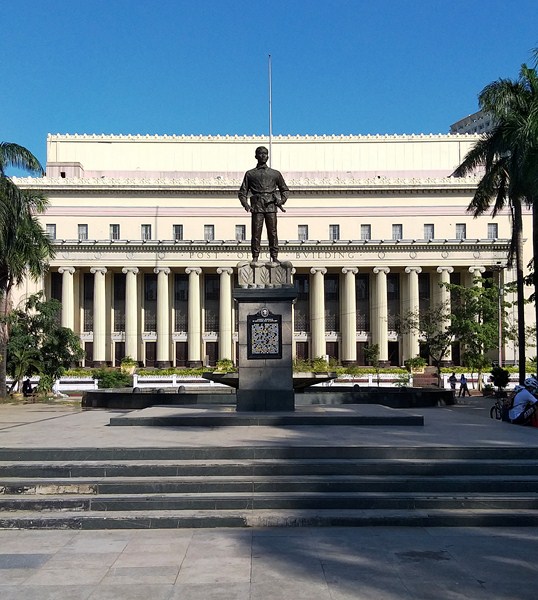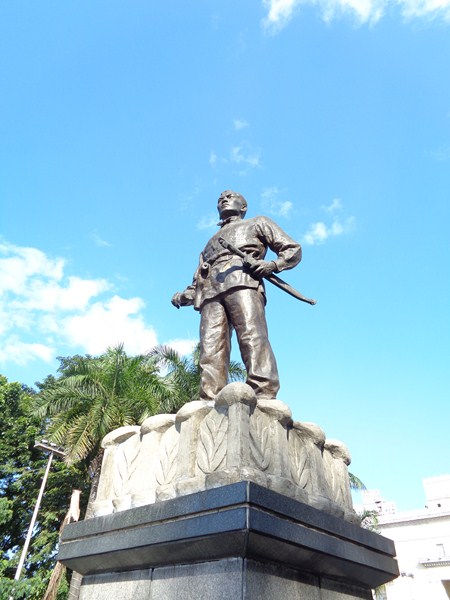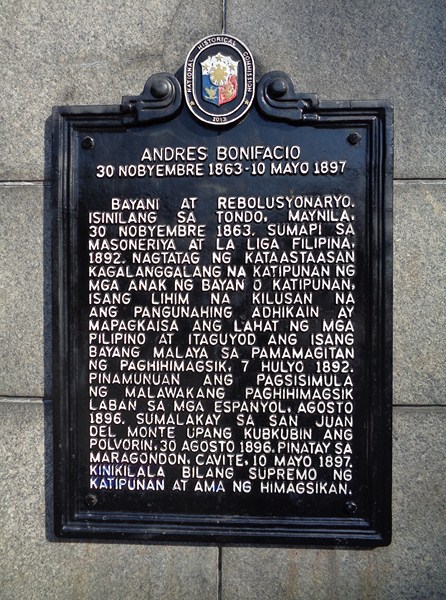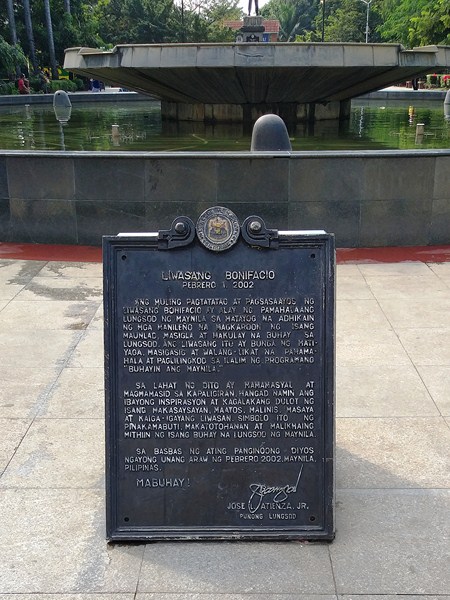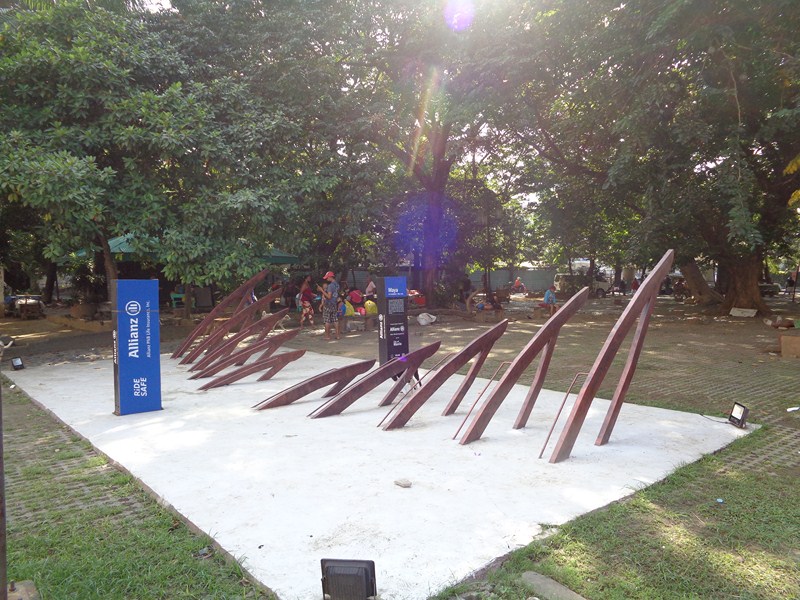For my first city tour since the COVID-19 lockdown, Jandy and I joined the Pasig River Heritage Walk, sponsored by Renacimiento Manila and conducted by its president Mr. Diego Torres. Our assembly area, fitfully, was to be at the 700 sq. m. Liwasang Bonifacio (Bonifacio Square), one of four freedom parks in the City of Manila (the others are Plaza Miranda, Plaza Dilao and Plaza Moriones), where protests and rallies may be held without requiring permission from local authorities. Since the dark days of Martial to the post dictatorship years, the plaza has been a popular site of protests and demonstrations organized by several leftist groups.
This city square and transport hub, straddling the dividing line between Ermita and Intramuros, is the starting point of Padre Burgos Avenue which connects to Taft Avenue and Roxas Boulevard in Rizal Park and lies at the south end of Jones Bridge, MacArthur Bridge, and Quezon Bridge that link the northern districts of Binondo, Santa Cruz, and Quiapo to the central district of Ermita. Today, this plaza is a visual foil for two Juan Arellano structures – the Manila Central Post Office and the Manila Metropolitan Theater.
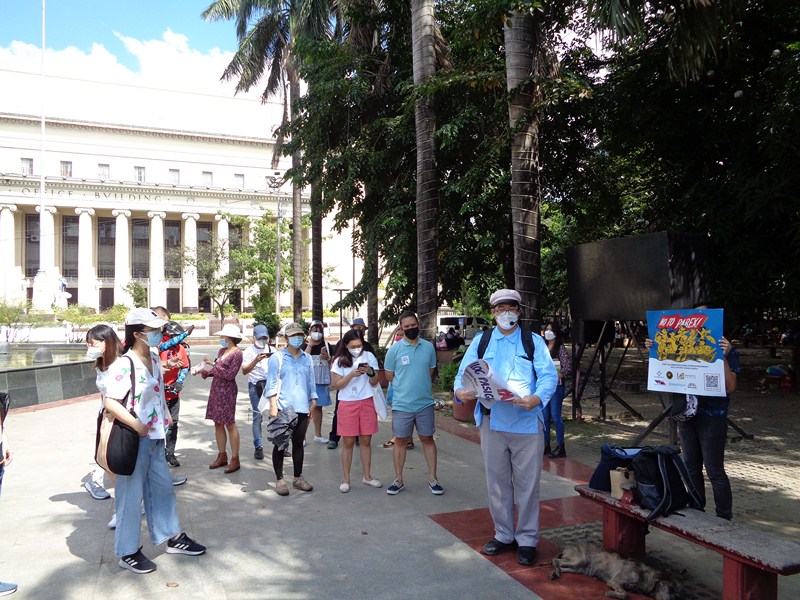
Participants of the Pasig River Heritage Walk gathered around Mr. Diego Torres (in blue), president of Renacimiento Manila, the organizer of the walking tour
During the Spanish Colonial era, the land that is now Liwasang Bonifacio and the Manila Central Post Office was the Cuartel del Fortín. This small fortress, guarding the Pasig River east of Fort Santiago, was located at the site of the Parián de Arroceros, an early Chinese trading village east of Intramuros (in what was the first bend of the Pasig River). The marketplace of Intramuros, the community, although closely guarded by the Spanish, eventually grew, with its own parish church, cemetery and stores (such as the Arroceros Rice Market) and soon became Manila’s early economic and trading hub.
In the decades after the British Occupation of Manila from 1762 to 1764, the closeness and support of the Chinese to the British provided the Spanish with justification to deport and, subsequently, ban them from the country. The Parián’s close proximity to the walls of Intramuros made it a security threat and was demolished and the Chinese ghetto and marketplace was moved, north of the Pasig River, to Binondo and Santa Cruz.
The area of the former Parián, now a vast marshy open field, was soon filled, by the Spaniards, with several barracks including the quarters of a contingent of the Spanish infantry regiment, near the Fortin of the Puente Grande (now occupied by the Manila Central Post Office Building). In front of the Fortin is the Plaza del Fortín, a small plaza surrounded by stone benches and trees which also doubled as a public recreation area at night where early residents would gather to hear musical performances.
In the early 1900s, the plaza was renamed as Plaza Lawton after Henry Ware Lawton, the American general who was killed, during the Philippine–American War, by a Filipino sharpshooter named Bonifacio Mariano in the Battle of Paye (also known as the Battle of San Mateo), in the area partly occupied by Bagong Silangan, Quezon City) on December 19, 1899. The Manila tranvía had a terminal in the plaza.
In 1963, the plaza was renamed after Andres Bonifacio, the revolutionary leader who founded the independence movement of Katipunan during the Spanish colonial rule. A monument in his honor, designed by National Artist for Sculpture (1973) Guillermo Tolentino to commemorate his birth centennial, now stands in the center of the plaza. Tolentino also designed the Bonifacio Monument along EDSA but, unlike this bolo-wielding statue the one at Liwasang shows Bonifacio with a quiet dignity – a gaze of steel, arms raised near his hips and hands poised to draw his bolo and fight.
Check out “The Andres Bonifacio Monument”
In 2002, the plaza was refurbished (with design assistance from the Heritage Conservation Society) with a fountain as its centerpiece flanked by fully grown royal palm trees (providing a majestic vista of the Manila Central Post Office’s façade) and, in 2012, in order to protect the zone from further urbanization, the National Historical Commission of the Philippines (NHCP) declared the plaza as a National Historical Landmark.
Check out “Manila Central Post Office Building,” “Revitalized Jones Bridge” and “Quezon Bridge”
The Liwasang is frequented by bikers who use the fountain as a rest stop, posing for selfies beside the monument. As such, near the monument is a bike rack cum art installation called “Maya,” one of four (the others are the “Kalesa” at Plaza Roma, “Alon” at Rajah Sulayman Park and “Tabak” at the Kartilya ng Katipunan) designed by Tondo-born and raised Mark Wesley Pahate and installed on May 8, 2021 (Flag Day) by Allianz PNB.
AUTHORS NOTES:
Despite these best efforts, the monument is still a pathetic sight as it is still, apparently, home to sidewalk vendors, beggars and vagrants, the shrubbery serving as drying area for their laundry and litter all around. The monument of Bonifacio, unlike that of Jose Rizal in Rizal Park, is tiny and, also unlike the latter, is not fenced off or watched over by an honor guard, though both are considered as National Heroes. Also, both have “national photobombers,” the Bonifacio Monument with its Manila Central Post Office (in fairness, this was built first) and the Rizal Monument with its 49-storey Torre de Manila Condominium.
Liwasang Bonifacio: Padre Burgos Avenue and Magallanes Street, Ermita
Manila.


